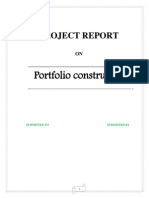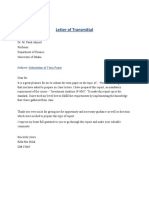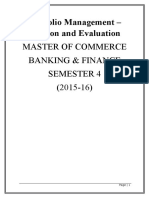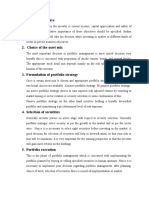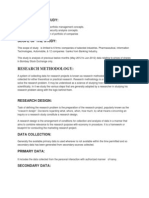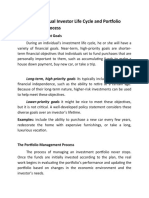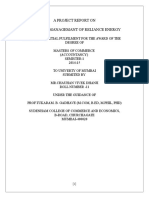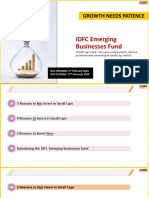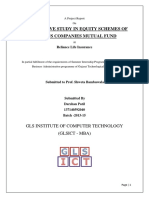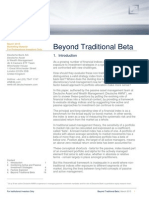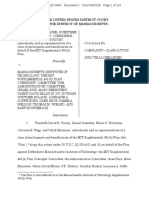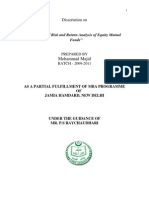Explain How You Go Making An Investment Process
Explain How You Go Making An Investment Process
Uploaded by
Gamuchirai Michael DereraOriginal Description:
Original Title
Copyright
Available Formats
Share this document
Did you find this document useful?
Is this content inappropriate?
Report this DocumentCopyright:
Available Formats
Explain How You Go Making An Investment Process
Explain How You Go Making An Investment Process
Uploaded by
Gamuchirai Michael DereraCopyright:
Available Formats
EXPLAIN HOW YOU GO MAKING AN INVESTMENT PROCESS
An investment is an asset or item that is purchased with the hope that it will generate income or
appreciate in value at some point in the future. An investment can refer to any mechanism used
for generating future income including bonds, stocks, real estate property or a business among
other examples. The process of investment involves careful study and analysis of the various
classes of assets and the risk-turn ratio attached to it.
An investment process is a set of guidelines that given the behavior of investors in a way which
allows them to remain faithful of the tenets of their investment strategy that is the key principles
which they hope to facilitate out-performance. There are five investment process steps that they
help you in selecting and investing in the best asset class according to your needs and
preferences. Below they are more details on every notes on investing process;
Step 1: UNDERSTANDING THE CLIENT
The first and the foremost step of investment process is to understand the client or the investor
his or her needs, his risk taking capacity and his tax status. After getting an insight of the goals
and restraints of the client, it is important to set a benchmark for the client’s portfolio
management process which will help in evaluating the performance and check whether the
client’s objectives are achieved.
Step 2: ASSET ALLOCATION DECISION
This step involves decision on how to allocate the investment across different asset classes that is
fixed income securities, equity and real estate. It also involves decision of whether to invest in
domestic assets or in foreign assets. The investors will make this decision after considering the
microeconomic conditions and overall market status.
Step 3: PORTFOLIO STRATEGY SELECTION
Third step in the investment process is to select the proper strategy creation. Choosing the sight
strategy for portfolio assets that will be added in the portfolio management process. The strategy
that conforms to the investment policies and investment objectives should be selected. There are
two types of portfolio strategy that is active management and passive management.
Active portfolio management process refers to a strategy where the objective of investing
is to outperform the market return compared to a specific benchmark by either buying
securities that are undervalued or by shot selling securities that are overvalued. In this
strategy it requires close attention by the investor or the fund management.
Passive portfolio management process refers to the strategy where the purpose is to
generate returns equal to that of the market. It is a reactive strategy as the fund manager
or the investor reacts after the market has respond.
Step 4: ASSET SELECTION DECISION
The investor needs to select the assets to be placed in the portfolio management process in the
fourth step. Within each asset class there are different sub asset-classes. For example in equity
which stocks should be chosen? Within the fixed income securities class, which bonds should be
chosen? Also the investment objectives should conform to the investment policies because
otherwise the main purpose of investment management process should become meaningless.
Step 5: EVALUATING PORTFOLIO PERFORMANCES
This is the final step in the investment process which evaluates the portfolio management
performances. This is an important step as it measures the performance of the investment with
respect to a benchmark in both absolute his objectives are being achieved or not achieved.
In conclusion, after all the above steps of an investment process, the investor needs to keep
monitoring the portfolio management performance at an appropriate interval should also
incorporate a sustainable investing process that allows you to hit the market done. That is
because the investment process provides you with a systematic way to create and handle a
portfolio aligned with your financial goals while seeking to manage the investment risk.
References
Dr Paresh B. Shah & Billy Singh Fundamentals of Financial Management.
Jiman Managerial Finance 11-14th edition Colling MzamaniUni.
Fredrick Owen Skae, Fancisco Antonio Amaral Virgario Managerial Finance.
You might also like
- Dimensional Fund Advisors 2002 Case SolutionDocument10 pagesDimensional Fund Advisors 2002 Case SolutionRohit Kumar80% (5)
- Brinson Et Al. (1986) - Determinants of Portfolio PerformanceDocument7 pagesBrinson Et Al. (1986) - Determinants of Portfolio Performanceadf237Noch keine Bewertungen
- NCFM Mutual Fund Begginer ModuleDocument71 pagesNCFM Mutual Fund Begginer ModuleIshpreet SinghNoch keine Bewertungen
- Project Report On Portfolio ConstructionDocument37 pagesProject Report On Portfolio ConstructionMazhar Zaman67% (3)
- Viking Onshore - 4Q 2008 LetterDocument16 pagesViking Onshore - 4Q 2008 LetterDealBook100% (15)
- Portfolio Management Services in India Final Copy 100 Marks ProjectDocument55 pagesPortfolio Management Services in India Final Copy 100 Marks ProjectameyawarangNoch keine Bewertungen
- Investment Management: 5 Important Steps of Investment ProcessDocument3 pagesInvestment Management: 5 Important Steps of Investment ProcessAnkit SinglaNoch keine Bewertungen
- Investment ProcessDocument21 pagesInvestment ProcessLady Marianne Anuran AtienzaNoch keine Bewertungen
- Set A Firm Foundation With Asset Allocation: Step 1-Understanding The ClientDocument5 pagesSet A Firm Foundation With Asset Allocation: Step 1-Understanding The ClientPalha KhannaNoch keine Bewertungen
- What Is Portfolio ManagementDocument14 pagesWhat Is Portfolio Managementnisha.shahi076Noch keine Bewertungen
- Portfolio ManagementDocument15 pagesPortfolio Managementnisha.shahi076Noch keine Bewertungen
- Abhi FinalDocument9 pagesAbhi Finalanon_244519626Noch keine Bewertungen
- CHAPTER 4 Written ReportDocument5 pagesCHAPTER 4 Written Report1621bcguardiansNoch keine Bewertungen
- 5286985Document54 pages5286985Lucky GaleraNoch keine Bewertungen
- SAPM SummaryDocument2 pagesSAPM SummaryFaisal MehmoodNoch keine Bewertungen
- Portfolio MGMTDocument5 pagesPortfolio MGMTJessamine PanedaNoch keine Bewertungen
- Chapter 7 - Portfolio inDocument12 pagesChapter 7 - Portfolio intemedebereNoch keine Bewertungen
- Introduction of PortfoliosDocument10 pagesIntroduction of PortfoliosAbdul LathifNoch keine Bewertungen
- Portfolio Management and Perfomance EvaluationDocument14 pagesPortfolio Management and Perfomance EvaluationAnishahNoch keine Bewertungen
- Letter of Transmittal: Subject: Submission of Term PaperDocument17 pagesLetter of Transmittal: Subject: Submission of Term PaperRifat HelalNoch keine Bewertungen
- Chapter 1 Portfolio Construction Robert A. StrongDocument13 pagesChapter 1 Portfolio Construction Robert A. StrongAlex 111Noch keine Bewertungen
- Ia Unit 1Document18 pagesIa Unit 121ubha116 21ubha116Noch keine Bewertungen
- Personal FinanceDocument9 pagesPersonal FinanceAnubhav SoodNoch keine Bewertungen
- Portfolio Evaluation and RevisionDocument32 pagesPortfolio Evaluation and RevisionHarshit Gandhi100% (1)
- Business ObjectiveDocument2 pagesBusiness ObjectiveKaran PurswaniNoch keine Bewertungen
- Portfolio Management and Investment DecisionsDocument74 pagesPortfolio Management and Investment DecisionsChillara Sai Kiran NaiduNoch keine Bewertungen
- Portfolio Management: Noorulhadi QureshiDocument10 pagesPortfolio Management: Noorulhadi QureshiVimala Selvaraj VimalaNoch keine Bewertungen
- Portfolio RevisionDocument28 pagesPortfolio RevisionRaj YadavNoch keine Bewertungen
- Portfolio Management NetworthDocument87 pagesPortfolio Management NetworthAdiseshu ChowdaryNoch keine Bewertungen
- MF0001 Security AnalysisDocument24 pagesMF0001 Security Analysisnsmu838Noch keine Bewertungen
- Portfolio Management - India BullsDocument103 pagesPortfolio Management - India BullsNarsing Rao BodduNoch keine Bewertungen
- Pair Assignment 552Document7 pagesPair Assignment 552NURUL SYAFIZAH MOHD ALINoch keine Bewertungen
- Investing ProcessDocument3 pagesInvesting ProcessJineet SadariaNoch keine Bewertungen
- Security Analysis & Portfolio Managemnt DDocument7 pagesSecurity Analysis & Portfolio Managemnt Domkar chalkeNoch keine Bewertungen
- Lecture ThreeDocument9 pagesLecture ThreeDenzel OrwenyoNoch keine Bewertungen
- Banking and FinanceDocument8 pagesBanking and FinanceRavina pareraoNoch keine Bewertungen
- What Is An Investment PhilosophyDocument10 pagesWhat Is An Investment PhilosophyArafat DreamtheterNoch keine Bewertungen
- Portfolio Management of Reliance SecuritiesDocument29 pagesPortfolio Management of Reliance SecuritiesVasavi DaramNoch keine Bewertungen
- Managing A Stock Portfolio A Worldwide Issue Chapter 11Document20 pagesManaging A Stock Portfolio A Worldwide Issue Chapter 11HafizUmarArshadNoch keine Bewertungen
- Objectives & Scope of Portfolio ManagementDocument4 pagesObjectives & Scope of Portfolio ManagementGourav BaidNoch keine Bewertungen
- Project On Portfolio ManagementDocument13 pagesProject On Portfolio Managementpayal22octNoch keine Bewertungen
- Part 1 & 2Document12 pagesPart 1 & 2Monoarul Islam JawadNoch keine Bewertungen
- TOPIC I - IntroductionDocument10 pagesTOPIC I - IntroductionJeffrey RiveraNoch keine Bewertungen
- Intro To Portfolio MGTDocument39 pagesIntro To Portfolio MGTLea AndreleiNoch keine Bewertungen
- Presentation 14Document16 pagesPresentation 14Rakesh ShuklaNoch keine Bewertungen
- Class Report For Investment ManagementDocument5 pagesClass Report For Investment ManagementS VasanthNoch keine Bewertungen
- Topic 2 Katkat Report...Document2 pagesTopic 2 Katkat Report...Maria Isabelle DamascoNoch keine Bewertungen
- Id 49 BMDocument13 pagesId 49 BMMd Majedul HaqueNoch keine Bewertungen
- Vivek ProjectDocument93 pagesVivek ProjectMohmmedKhayyumNoch keine Bewertungen
- Portfolio Management ServicesDocument24 pagesPortfolio Management ServicesASHI100% (5)
- Steps of Portfolio Management Process /steps of Portfolio ManagementDocument8 pagesSteps of Portfolio Management Process /steps of Portfolio ManagementRuchi KapoorNoch keine Bewertungen
- 1 - Overview of Financial MarketsDocument31 pages1 - Overview of Financial MarketsJeffrey RiveraNoch keine Bewertungen
- What Is Portfolio Management and Why Is It Good For Investment PlanningDocument12 pagesWhat Is Portfolio Management and Why Is It Good For Investment PlanningJeffrey RiveraNoch keine Bewertungen
- Portfolio Management NoteDocument9 pagesPortfolio Management NoteMd FahadNoch keine Bewertungen
- Portfolio Management 1,2,3 Chapter PDFDocument53 pagesPortfolio Management 1,2,3 Chapter PDFSri LekhaNoch keine Bewertungen
- Financial Policy and Corporate StrategyDocument10 pagesFinancial Policy and Corporate StrategyPravesh PangeniNoch keine Bewertungen
- Yasir Bhai ProjectDocument71 pagesYasir Bhai ProjectFaizan Sir's TutorialsNoch keine Bewertungen
- SR - No Topics: Meaning of Portfolio ManagementDocument70 pagesSR - No Topics: Meaning of Portfolio ManagementChandan RaiNoch keine Bewertungen
- Portfoliomanagementppt 190401103934Document16 pagesPortfoliomanagementppt 190401103934Aparna MahapatraNoch keine Bewertungen
- Portfolio MIDDocument59 pagesPortfolio MIDjscqyrjbynNoch keine Bewertungen
- How Beginners Achieve Financial Success: A Guide to Understanding Risk and ReturnFrom EverandHow Beginners Achieve Financial Success: A Guide to Understanding Risk and ReturnNoch keine Bewertungen
- Unlocking the Secrets of Value Investing: Building Wealth Through the Stock MarketFrom EverandUnlocking the Secrets of Value Investing: Building Wealth Through the Stock MarketNoch keine Bewertungen
- Attitude Theory3Document3 pagesAttitude Theory3Gamuchirai Michael DereraNoch keine Bewertungen
- Anthropological Approach To Consumer Science - A Practical Teaching Case StudyDocument9 pagesAnthropological Approach To Consumer Science - A Practical Teaching Case StudyGamuchirai Michael DereraNoch keine Bewertungen
- ZB 5csDocument3 pagesZB 5csGamuchirai Michael DereraNoch keine Bewertungen
- Questionnaire PRODocument4 pagesQuestionnaire PROGamuchirai Michael DereraNoch keine Bewertungen
- Zimbabwe Stock Exchange (ZSE)Document6 pagesZimbabwe Stock Exchange (ZSE)Gamuchirai Michael DereraNoch keine Bewertungen
- Traffic Signs and Signals: Easy Go Driving School KwekweDocument11 pagesTraffic Signs and Signals: Easy Go Driving School KwekweGamuchirai Michael DereraNoch keine Bewertungen
- Marginal Costing & C.V.P AnalysisDocument6 pagesMarginal Costing & C.V.P AnalysisGamuchirai Michael DereraNoch keine Bewertungen
- Retail MGT Notes-1Document77 pagesRetail MGT Notes-1Gamuchirai Michael DereraNoch keine Bewertungen
- Building A Global Core-Satellite Portfolio: Executive SummaryDocument12 pagesBuilding A Global Core-Satellite Portfolio: Executive SummarydospxNoch keine Bewertungen
- A Project Report On "Analysis of Mutual Fund-As An Indicator For Investment Decision Making"Document76 pagesA Project Report On "Analysis of Mutual Fund-As An Indicator For Investment Decision Making"Payal PatelNoch keine Bewertungen
- Mutual Funds Distributor Exam NotesDocument40 pagesMutual Funds Distributor Exam Notesprakash naga100% (1)
- Project Report On: at Wallet For WealthDocument54 pagesProject Report On: at Wallet For WealthPARTHA100% (1)
- Damodaran PDFDocument71 pagesDamodaran PDFADRIANA LUCIA CARMONA ROMERONoch keine Bewertungen
- Summary of A Primer For Investment TrusteesDocument7 pagesSummary of A Primer For Investment TrusteesjonathanwsmithNoch keine Bewertungen
- Basic Tools of FinanceDocument13 pagesBasic Tools of FinanceGayle AbayaNoch keine Bewertungen
- IIFL Nifty ETF PresentationDocument25 pagesIIFL Nifty ETF Presentationrkdgr87880Noch keine Bewertungen
- Mutual Fund ProjectDocument90 pagesMutual Fund ProjectAgnel Fernandes100% (1)
- Mutual FundDocument43 pagesMutual Fundsssagar92100% (1)
- What Book Should I Read To Gain Knowledge About Finance, The Stock Market, and Investing Topics - QuoraDocument11 pagesWhat Book Should I Read To Gain Knowledge About Finance, The Stock Market, and Investing Topics - Quoraachint8kumarNoch keine Bewertungen
- A Project Report On Strategic Managemant of Reliance EnergyDocument46 pagesA Project Report On Strategic Managemant of Reliance EnergyK-Ayurveda WelexNoch keine Bewertungen
- Presentation-IDFC Emerging Businesses Fund PDFDocument29 pagesPresentation-IDFC Emerging Businesses Fund PDFani dNoch keine Bewertungen
- Industry Profile: Money Market Schemes: Money Market Schemes Aim To Provide Easy Liquidity, Preservation of CapitalDocument22 pagesIndustry Profile: Money Market Schemes: Money Market Schemes Aim To Provide Easy Liquidity, Preservation of CapitalJohn SmithNoch keine Bewertungen
- PRUlink One Miss 2012sep14 1347555221929Document20 pagesPRUlink One Miss 2012sep14 1347555221929viki86Noch keine Bewertungen
- A Project Report On Comparative Study inDocument82 pagesA Project Report On Comparative Study inBhawna Rajput100% (1)
- Retirement Fees Lawsuit Filed Against Duke UniversityDocument98 pagesRetirement Fees Lawsuit Filed Against Duke UniversitythedukechronicleNoch keine Bewertungen
- 03 Literature ReviewDocument15 pages03 Literature ReviewrakeshNoch keine Bewertungen
- Beyond Traditional Beta 032015Document24 pagesBeyond Traditional Beta 032015Ton ChockNoch keine Bewertungen
- Pension FundsDocument24 pagesPension FundsRonica MahajanNoch keine Bewertungen
- NISM VA Mutual Fund Short NotesDocument38 pagesNISM VA Mutual Fund Short NotesAryan PanditaNoch keine Bewertungen
- Setting The Record Straight: Truths About Indexing: Vanguard Research January 2018Document12 pagesSetting The Record Straight: Truths About Indexing: Vanguard Research January 2018TBP_Think_TankNoch keine Bewertungen
- MIT ComplaintDocument104 pagesMIT ComplaintUnited Press InternationalNoch keine Bewertungen
- Risk and Return Analysis of Equity Mutual FundDocument90 pagesRisk and Return Analysis of Equity Mutual Fundmajid_khan_4Noch keine Bewertungen
- Money - December 2015 VK Com EnglishmagazinesDocument92 pagesMoney - December 2015 VK Com EnglishmagazinesshyamsailusNoch keine Bewertungen



